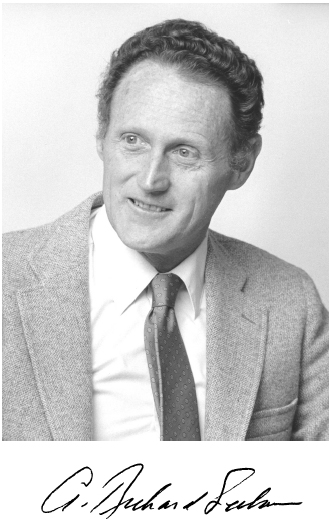
1936–2000
Elected in 1985
“For fundamental contributions in aerodynamic theory related to development of computational fluid mechanics and for service in engineering education.”
BY GEORGE H. BORN
A. RICHARD SEEBASS was one of the country’s most respected engineering deans and probably the most energetic. He was born on March 27, 1936, in Denver, Colorado, the son of Alfred Richard Seebass Jr. and Marie Wright Seebass, and died in Boulder of pneumonia on November 14, 2000, at the age of 64.
After graduating from Smiley Middle School and East High School in Denver, Dick attended Princeton University, where he graduated magna cum laude in engineering in 1958 and then earned an MS degree in aeronautical engineering. He married Nancy Palm of Denver on June 19, 1958, and continued his studies as a Woodrow Wilson fellow at Cornell University, completing his PhD in aerospace engineering in 1962, when he joined Cornell’s faculty as an assistant professor. By 1972 he was associate dean of Cornell’s College of Engineering. In 1975 he joined the University of Arizona as a professor of aerospace and mechanical engineering and of mathematics, where he coestablished the mathematics program.
In August 1981, he became dean of the College of Engineering and Applied Science and professor of aerospace engineering sciences at the University of Colorado Boulder. He championed a formal development plan for the college and led a successful
Centennial Campaign that resulted in contributions of $52.2 million. Under his leadership, private gifts were committed to build the Gemmill Engineering Library, launch the Herbst Program of Humanities for Engineers, create the Lockheed Martin Engineering Management Program, and triple the college’s scholarships. During his 13 years of stewardship, the college founded several research centers and increased research revenues from $3 million in 1981 to $36 million in 1994. The research centers include one of 18 National Science Foundation Research Centers, one of eight NASA Space Engineering Research Centers, and one of seven awards for Grand Challenge Applications. Furthermore, he expanded the faculty from 95 to 156, bringing in many new faculty of national distinction. His administration’s strategic plan set ambitious goals for increasing underrepresented minority and women students and faculty in engineering, resulting in a doubling of their numbers during his tenure. In recognition of Dick’s vision for undergraduate educational reform, the college’s innovative Integrated Teaching and Learning Laboratory was dedicated to him when it opened in April 1997.
Professor Seebass also chaired the Department of Aerospace Engineering from August 1995 through May 1999, leading a complete reform of the undergraduate curriculum. The department graduated its first class with the new interdisciplinary, hands-on curriculum in May 2000. Many of his students have gone on to become outstanding engineers and researchers.
Dick Seebass was a nationally and internationally renowned aerodynamicist. He made important and extensive contributions to the analysis of unsteady, transonic flows and of shock-free, three-dimensional, supercritical flows. In addition, he advanced understanding of ways to minimize the effects of a sonic boom and helped to develop computational fluid mechanics and aerodynamics as a practical tool for designers and engineers.
His research earned him professional recognition and many prestigious awards. He was elected to the National Academy of Engineering in 1985 for his fundamental contributions
in aerodynamic theory related to the development of computational fluid mechanics and for service in engineering education. In addition, he was awarded the Max Planck Research Prize (shared with Helmut Sobieczky, 1991), the American Institute of Aeronautics and Astronautics’ William F. Durand Medal and Lectureship (1994), and the International Astronautics Federation’s Frank J. Malina Medal (1994) for contributions to space education. He received the CU Boulder College of Engineering’s Centennial Medal in 1993 and the University Medal in 1994.
When Dick came to CU Boulder in 1981, it was a return to the Rocky Mountains that he loved. Home at last, he enjoyed many years of hiking and fly fishing with family and friends near their cabin in Estes Park. During their last two years, he and Nancy traveled extensively around the world.
Dick is survived by sons Erik Seebass of San Francisco and Scott Seebass of Berkeley; sister Linda Johnson of Land O’ Lakes, Wisconsin; and three grandsons. Nancy, his life partner, soul mate, and wife of 42 years, died on November 27, 2000.
Dick’s unselfish pursuit of excellence, his commitment to preparing the engineers of the future, and his friendship with the many people whose lives he touched will be missed.




